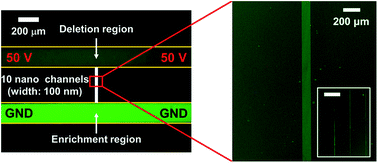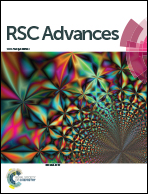A novel nanochannel fabrication for nanofluidic applications using synchrotron radiation via a micro patterned X-ray mask†
Abstract
Micro- and nanofluidic devices are being used increasingly in biological, chemical, and medical applications, and many fabrication methods have been proposed. While micro-sized structures are simply fabricated using standard ultraviolet (UV) lithography processes, there are still limitations in the fabrication of nano-sized structures. This study presents a novel X-ray mask fabrication method for fabricating extremely long nano-sized channels using synchrotron radiation (width and height: ∼200 nm, length: ∼2 cm). The X-ray mask used for manufacturing the nano-sized channels can simply be fabricated by depositing metal on microstructures tilted at a specific angle. The proposed method overcomes the limitations of traditional nanofabrication methods, which are complex, expensive, and time-consuming. Using the fabricated nanochannels, the generation of ion concentration polarization, a novel transport phenomenon in nanofluidics, was investigated. Our novel fabrication method should be a useful tool for various nanofluidic applications due to its various advantages, including simple fabrication process, controllability, and duplicability.


 Please wait while we load your content...
Please wait while we load your content...